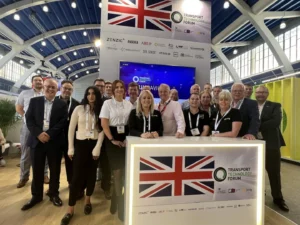On the cover of the 2016 Transport Scotland Road Safety Strategy is a picture of the Sheriffhall Roundabout on the A720 in Scotland. There perhaps couldn’t be greater recognition for a unique project-the first of its kind in the UK – where use of intelligent road studs had a significant positive impact on collision risk at the roundabout through reduced lane transgressions, meaning less congestion and more importantly fewer accidents.
The scheme went on to win six awards, testament to Clearview Intelligence’s use of ‘out of the box’ thinking combined with new technology. In many ways it also typifies the company’s intimate understanding of the Scottish road network after years of working closely with Transport Scotland, its contractors and many local authorities.
It has been one of many successful projects in Scotland delivered by Clearview Intelligence, and the list is getting longer by the year.
As Director of Business in Scotland, it is Chris Keenan’s responsibility to continuously find the right solutions for the challenges his clients face on a daily basis and given the success he has had in the past, he has a lot to live up to. But in the last few years he has helped increase the company’s success in Scotland even further. And there is more to come. “Having had success over so many years in Scotland drives us to continue to think of more innovative ways to keep the Scottish roads safer and more efficient,” says Chris.
Although this is an interview with him, he is less keen to talk about himself and much more inclined to let the projects themselves do all the talking.
The Sherrifhall project was not a site where the ‘norm’ could be applied. The accident rates on the roundabout were very high – the highest number of collisions on any roundabout on the Scottish trunk road network in the decade leading to 2013. The thought of using active road studs to guide traffic around the roundabout lanes was a sensible one. But a potential issue became apparent that drivers on the circulatory carriageway from the minor arms would be confused by the studs, according to Chris.
Instead, the solution came in the form of a scheme using actively controlled road studs whereby the studs are synchronised in coordination with the A720 traffic signals on the roundabout. With the new system in place, as soon as the traffic signals on the entrance to the roundabout turns green, studs embedded in the road surface immediately illuminate and guide drivers onto the appropriate lanes of the roundabout. As the traffic signal turns red, all of the studs on that section switch off and the studs at the next section illuminate as the corresponding traffic signals turns green. In this way, drivers now get an illuminated green phase to guide them all the way around and off the roundabout, with clear visual definition of the lanes to heighten lane discipline and reduce preventable collisions.
“A couple of years later we reached another milestone with the SolarLite Active Road Studs following the installation of 4,100 of them along a 14 mile stretch of the A1 to help solve problems related to the road originally being unlit,” says Chris.
This scheme, where Clearview worked with Transport Scotland, Amey and Edinburgh Napier University, emphasised the delineation of the road layout and junctions, providing up to 900 metres of visibility from high intensity LEDs – a distance ten times greater than that offered by conventional reflective road studs.
The design of the new delineation scheme ensures that all major junctions are clearly lit and treated consistently. This was following concerns which were raised about the unlit road by the A1 Action Group. A key issue was in relation to entering or exiting the A1 during hours of darkness. A lack of visibility, poor junction definition, and inconsistency in signage and road markings were highlighted as significant problems.
“The feedback from the scheme was amazing, especially with the enhanced visibility reducing erratic driving behaviour, making drivers feel more confident driving at night. The fact that the studs were chosen over streetlights on this road was a real step-change and this approach has been applied to other roads in Scotland such as the A9,” he adds. “It proves that the approach of just applying the same technology and methods time and time again to solve new challenges just doesn’t work and I am proud of the fact that success has come from enabling us to think differently to make Scottish roads safer.”
Other projects that have gained recognition include ‘ground-breaking’ work on the A701 where inductive loops located in the trunk road, identify the specific vehicle-class and transmit this to LED signs located 100m to 120m along the road, delivering bespoke messages. Research had found that smaller vehicle classes leave far less headway, with an average of 25% travelling at an inappropriate distance i.e. ‘close following’. In this case, for example, the system therefore displays the activated message ‘Too Close, Please leave 2 second gap’ to notify drivers of the gap between them and the vehicle in front.
Elsewhere, after reported wrong way slip detections on the same road on a weekly basis, Clearview installed a ‘wrong way detection system’ that detects vehicles travelling the wrong way up the slip road and will then trigger a vehicle activated ‘No Entry’ warning sign. Although an average of 5 people a week are still making the wrong manoeuvre, the signs highlight their mistake, and they turn around before reaching the mainline of the A720. “An unbelievable statistic in many ways but a dangerous one and another solution that we can say has solved the problem on that road,” says Chris.
But what about the future? This year marked the launch of Transport Scotland’s most ambitious road safety strategy. The Road Safety Framework to 2030 sets out a ‘compelling long-term vision’ for road safety, Vision Zero.
The journey to achieving this vision will also include ambitious interim targets where the number of people being killed or seriously injured on our roads will be halved by 2030, according to Transport Scotland. This will include a fund to help local authorities meet the targets. “This is crucial if we are to have a consistent approach across all networks. Local authorities are always constrained by budgets, but this enables them to be supported to help deliver safer schemes,” he says. “With so many active travel schemes going in, how do we ensure they are maintained to a level that ensures safety?” he adds.
“Looking at the statistics over the last ten years then accident rates have plateaued but is the loss of one life ok? – of course it isn’t. The latest strategy is an attempt to get standards even higher. Scotland has a history of producing a nation of inventors, and innovation will play a crucial role in the government obtaining their targets,” says Chris.
“In regular conversations with the four operating companies, the safe system approach comes up in discussion at every meeting and albeit not necessarily a new approach it will be one that remains central to the strategy moving forward,” he adds. “In my opinion the ‘V2X’ communication will play an even bigger role in the future and especially as we move to more connected cars and eventually autonomy. The ability to specifically target drivers via in-car technology will help achieve that Vision Zero that we are looking for. The V2X ‘offer’ is not yet complete but will have a really dramatic increase on accident figures, ” he adds.
“But the secret is having that as well as everything else we do, not instead of. Warning signs in whatever form will be just as important and if you take them away you just confuse drivers even more,” says Chris. “With this in mind, our Connex and Insight platforms will, I am sure, play a crucial role in bringing key safety infrastructure together. Valuable, detailed data will be the thing that helps operators and local authorities make better decisions,” he adds. Chris also thinks drones will play a bigger role in helping to survey roads in the future leading to immediate changes in road design, speeds, and signals etc. to help improve safety and deal with congestion issues. Again it’s about making the best use of new technology to help deliver safer roads in the future.“





















